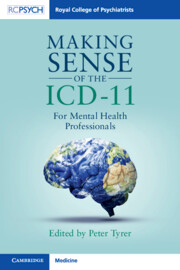Book contents
- Making Sense of the ICD-11
- Making Sense of the ICD-11
- Copyright page
- Contents
- Contributors
- Introduction
- Chapter 1 Development and Innovation in the ICD-11 Chapter on Mental, Behavioural and Neurodevelopmental Disorders
- Chapter 2 ICD-11 + DSM-5 = A Diagnostic Babel
- Chapter 3 Schizophrenia or Other Primary Psychotic Disorders
- Chapter 4 Mood Disorders
- Chapter 5 Disorders Specifically Associated with Stress
- Chapter 6 Disorders Due to Substance Use
- Chapter 7 Child and Adolescent Psychiatric Disorders
- Chapter 8 Anxiety and Fear-Related Disorders and Obsessive–Compulsive and Related Disorders
- Chapter 9 Personality Disorders
- Chapter 10 Disorders of Intellectual Development
- Chapter 11 Eating Disorders
- Chapter 12 Mental Health Classifications in Primary Care
- Index
- References
Chapter 8 - Anxiety and Fear-Related Disorders and Obsessive–Compulsive and Related Disorders
Published online by Cambridge University Press: 13 October 2023
- Making Sense of the ICD-11
- Making Sense of the ICD-11
- Copyright page
- Contents
- Contributors
- Introduction
- Chapter 1 Development and Innovation in the ICD-11 Chapter on Mental, Behavioural and Neurodevelopmental Disorders
- Chapter 2 ICD-11 + DSM-5 = A Diagnostic Babel
- Chapter 3 Schizophrenia or Other Primary Psychotic Disorders
- Chapter 4 Mood Disorders
- Chapter 5 Disorders Specifically Associated with Stress
- Chapter 6 Disorders Due to Substance Use
- Chapter 7 Child and Adolescent Psychiatric Disorders
- Chapter 8 Anxiety and Fear-Related Disorders and Obsessive–Compulsive and Related Disorders
- Chapter 9 Personality Disorders
- Chapter 10 Disorders of Intellectual Development
- Chapter 11 Eating Disorders
- Chapter 12 Mental Health Classifications in Primary Care
- Index
- References
Summary
Anxiety and Fear-Related Disorders and Obsessive-Compulsive and Related Disorders are two new groupings in the Mental, Behavioural, or Neurodevelopmental Disorders chapter of ICD-11. This chapter reviews key aspects of the two new groupings and their component disorders, beginning with a discussion of debates about the ICD-11 meta-structure, and including a review of the nosological research on anxiety and obsessive-compulsive disorders that is the foundation for the choices made by ICD-11. Mental disorders differ from chemical elements in important ways, and so a psychiatric nosology should not try to mimic the Periodic Table; indeed, ICD-11 takes a conceptual approach that acknowledges the fuzzy nature of mental disorders, and that foregrounds the fact that classification systems must be fit for purpose. ICD-11 represents an iterative advance in respect of Anxiety and Fear-Related Disorders and Obsessive-Compulsive Related Disorders that may lead to improved diagnostic practices, and so ultimately to better clinical interventions around the world.
Keywords
- Type
- Chapter
- Information
- Making Sense of the ICD-11For Mental Health Professionals, pp. 97 - 109Publisher: Cambridge University PressPrint publication year: 2023
References
- 1
- Cited by

